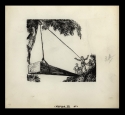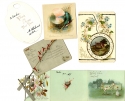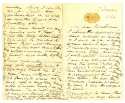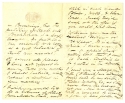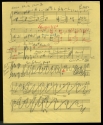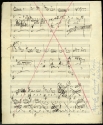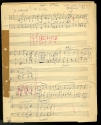We all have muses who inspire our creative side.
But what makes us create and innovate? How do we find that ‘Aha’ moment? Take a moment and try telling the person beside you the process by which original ideas come to you.
Organized around themes of Inspiration, Stages of Completion, Production, and Reception, each case sheds light on the creative process of individual artists. All of the materials in this exhibition can be found in the Booth Family Center for Special Collections.
The selection of items gathered for this exhibition capture the interplay of beginnings, ends, and betweens. They include not only completed works but also failed attempts, the different stages of the creative process, and ephemeral pieces that help to fill in the gap. But what is missing in your story? What would you add to this exhibit to embrace the silence and fuel the imagination? We have purposely left out exhibit labels in the display cases to invite you to create your own narrative. We hope to facilitate your experience of what is in these cases – not curate how you should understand them.
How do the items in each case tell a story? How do adjacent cases speak to each other? What stories do they suggest that are not represented? We encourage you to respond in your own way, whether by a conversation with a friend, getting out paintbrushes that you hid away years ago, whistling a tune as you walk down the sidewalk, or just by simply doing something that involves your imagination.
In this exhibition, creativity is expressed in many ways: architects and their visions of new buildings, sketches by patients from inside a hospital, authors and stories loosely related to their childhood, artists reimagining the look and shape of the book, costume sketches that mimic the gracefulness of artists on stage, and even a group of singing Jesuits performing on the same stage as the Supremes and Elvis Presley.
We hope that this inspires new opportunities of responding in your own way. Of imagining, of thinking, of seeing, of creating.
A Galerie of Art
 Artists’ books are an artform that came into its own in the twentieth century, with an array of ancestors. Generally related to but distinguished from the fine press tradition (in the vein of William Morris’ work with the Kelmscott Press) and livres d’artiste (or deluxe books, like Henri Matisse’s Jazz), artists’ books arise from a “zone of activity” (to borrow a phrase of Drucker) at the intersection of fields, disciplines, and ideas. Precedents range from the “illuminated printing” of William Blake to literary works that investigate text and image in book form like Laurence Sterne’s Tristram Shandy to Stéphane Mallarmé’s Un Coup de Dès (“A Throw of the Dice”), even back to Renaissance emblem books and certain medieval books, this artform galvanized in the early twentieth century through Constructivist, Futurist, and Surrealist attentions to the book and evolved in midcentury through Fluxus, Pop, and Conceptual adaptations and appropriations. The rich medium continues to grow through a community of regional centers, university programs, journals, national associations, and conferences. Although artists’ books have existed for some time, the study of this artform is still relatively young.
Artists’ books are an artform that came into its own in the twentieth century, with an array of ancestors. Generally related to but distinguished from the fine press tradition (in the vein of William Morris’ work with the Kelmscott Press) and livres d’artiste (or deluxe books, like Henri Matisse’s Jazz), artists’ books arise from a “zone of activity” (to borrow a phrase of Drucker) at the intersection of fields, disciplines, and ideas. Precedents range from the “illuminated printing” of William Blake to literary works that investigate text and image in book form like Laurence Sterne’s Tristram Shandy to Stéphane Mallarmé’s Un Coup de Dès (“A Throw of the Dice”), even back to Renaissance emblem books and certain medieval books, this artform galvanized in the early twentieth century through Constructivist, Futurist, and Surrealist attentions to the book and evolved in midcentury through Fluxus, Pop, and Conceptual adaptations and appropriations. The rich medium continues to grow through a community of regional centers, university programs, journals, national associations, and conferences. Although artists’ books have existed for some time, the study of this artform is still relatively young.
PRODUCTION | Just the Right Word
“Light” or “faint”?
“Gave” or “lavished”?
“Caterpillar” or “little green worm”?
“Strawberries and cream” or “ice cream”?
Word choice matters, or at least it did to Mark Twain when he put pen to paper to write The Adventures of Tom Sawyer. Throughout the manuscript Twain revisited his words, reworked his paragraphs, rethought his imagery. The three pages shown here attest to the sometimes painful process of editing our own creative work.
The Tom Sawyer manuscript was given to Georgetown in 1934 by Genevieve Garvan Brady, widow of Nicholas F. Brady. He had purchased the manuscript from the estate of Walter Bliss, son of Elisha Bliss. Elisha was Mark Twain’s American publisher. The manuscript is one of the great treasures in the Booth Family Center for Special Collections.
The first England edition of the book, shown here, was published earlier than the U.S. edition in order to secure British copyright. Today The Adventures of Tom Sawyer can be downloaded for free from various sources; it might be time to reread it and find a new appreciation for the evocative scene with the “little green worm,” who was almost a “caterpillar.”
INSPIRATION | Childhood
Children create a story in the moment, and draw masterpieces with a crayon. Sometimes adults reach back and tap into that mindset where words, images and music appear without effort. Our collections hold examples from creators of all sorts who draw inspiration from their own childhood and from the children around them; a few of them are featured here.
Joe Raposo, perhaps best known for his Sesame Street songs (see elsewhere in this exhibition), also wrote the wistful “There Used to Be a Ballpark” which Frank Sinatra recorded on his 1973 album “Ol’ Blue Eyes is Back” [Joseph G. Raposo Papers]. Mary O’Hara wrote about the Wyoming landscape around her through the eyes of a child…and a horse: My Friend Flicka. Pages from the manuscript of her autobiography talk about the spark of an idea that brought about that story [Mary O’Hara Papers].
Arthur Ransome wrote the award-winning Swallows and Amazons, “a book about childhood in the country where I had spent my own,” and its many sequels [Arthur Ransome Collection].
And artist and illustrator Lynd Ward, for whose artwork and personal papers the Georgetown University Art Collection is the primary repository, brought the improbable adventures and animals in The Swiss Family Robinson to life with his marvelous illustrations, and with author and wife Nanda Ward followed the adventures of The High Flying Hat.
Swinburne Inspirations
What informs and colors poetic creativity? For 19th-century British poet Algernon Charles Swinburne (1837-1909), inspiration grew from childhood memories of the seaside; the trauma of corporal punishment as an Eton schoolboy; his affection for children, especially the 5-year-old nephew of his friend Theodore Watts-Dunton; and most significantly his friendship with Dante Gabriel Rossetti, founder of the Pre-Raphaelite Brotherhood.
 In turn, Swinburne inspired life-long careers devoted to the collection and study of his work. John S. Mayfield’s private collection of Swinburne, now at the Booth Family Center for Special Collections (some items of which are displayed), is one of the finest in the world. Mayfield’s greatest achievement as a bibliophile was his collection of first editions of Swinburne’s critically acclaimed poem, “Atalanta in Calydon” (1865). By 1977, he had acquired 101.
In turn, Swinburne inspired life-long careers devoted to the collection and study of his work. John S. Mayfield’s private collection of Swinburne, now at the Booth Family Center for Special Collections (some items of which are displayed), is one of the finest in the world. Mayfield’s greatest achievement as a bibliophile was his collection of first editions of Swinburne’s critically acclaimed poem, “Atalanta in Calydon” (1865). By 1977, he had acquired 101.
 Foremost Swinburne scholar Terry L. Meyers, has also dedicated years of scholarship to the poet. Meyers is Chancellor Professor of English Emeritus at the College of William and Mary, Williamsburg, Va. He is author of The Uncollected Letters of Algernon Charles Swinburne (2004); and has given several talks on Swinburne at Georgetown University Library. On display is a journal notebook gifted to him by John S. Mayfield, so that he could record all of his Swinburne discoveries during his first research trip to England in 1975.
Foremost Swinburne scholar Terry L. Meyers, has also dedicated years of scholarship to the poet. Meyers is Chancellor Professor of English Emeritus at the College of William and Mary, Williamsburg, Va. He is author of The Uncollected Letters of Algernon Charles Swinburne (2004); and has given several talks on Swinburne at Georgetown University Library. On display is a journal notebook gifted to him by John S. Mayfield, so that he could record all of his Swinburne discoveries during his first research trip to England in 1975.
PRODUCTION | Costume Studies
These costume studies are by Prentiss Taylor (1885-1991) and Joan Caryl (1920-1985) both of whom were active in theater design early in their careers. Shown here are Taylor’s designs are for a ballet titled Beowulf and a production called Seventh Night of Seventh Moon. These pieces were probably created for small theatrical companies in New York City or Washington, D.C. where he was living in the mid-1920s. Joan Caryl’s drawings are for a classically based story drawn from Greek mythology. They might have been produced for a student production at Georgetown, where she taught from 1965 through 1970. Although both are works with a strong dance component, Caryl’s technique is much looser and fluid than Taylor’s more linear figural approach.
Beowulf (Prentiss Taylor, 1925): Prentiss Taylor wrote a scenario to accompany his designs for this ballet. As explained in the typed script, “The designs are constructed on the theory that Beowulf was a myth, hence they do not have to be strictly of the period in which the events are said to have taken place.” By creating costumes that were “out of the period,” Taylor freed himself to express types rather than adhering to historical accuracy. His work appears influenced by the famous designs of Léon Bakst for Serge Diaghilev’s Ballets Russes, which Taylor could have seen in magazines and other printed reproductions.
Untitled mythological production (Joan Caryl, n.d.): During the early 1940s, Joan Caryl worked as an assistant stage designer for Martha Graham while teaching stage lighting at Bennington College and design for dance in high school. The figures in Caryl’s drawings show elements of the legendary dancer Isadora Duncan, whose free-form, spontaneously flowing movement inspired the choreography of Martha Graham. In a drawing of Duncan by Abraham Walkowitz we find a similar approach to figures in motion through use of fluid black outline accented by washes of color.
PRODUCTION | Copyright 1
Copyright law promotes creativity by granting creators the exclusive right to profit from their works during the copyright term. Charles Dickens, a celebrity author in his day, was a vocal advocate for both longer copyright terms at home and international copyright protection. In 19th century America, foreign works were printed as quickly and cheaply as possible in order to get the books out to eager readers. Dickens’s immensely popular writings sold thousands of copies for which he received no compensation –this was entirely legal at the time since there were no international copyright treaties.
Dickens advocated throughout his life for more copyright protection in his books, letters, and speeches.
- Dickens dedicated The Pickwick Papers to Thomas Talfourd, Minister of Parliament, in appreciation for his support of legislation to provide “the authors of this and succeeding generations . . and their descendants a permanent interest in the copyright of their works.”
- In Nicholas Nickleby, Nicholas says to a literary gentleman, “You take the uncompleted books of living authors, fresh from their hands, wet from the press, cut, hack and carve them . . . all this without permission, and against his will; and then, to crown the whole proceeding, publish in some mean pamphlet. . . ”
- In a letter from Georgetown’s Special Collections, Dickens voices his support for an association whose objective is to “advance the cause of International copyright all over the world.”
PRODUCTION | Copyright 2
After the copyright term expires and a work enters the public domain, there are no restrictions on creating new works that adapt or build on the original work. Creators of the new works own the copyright in their original works.
For over a century now, Dickens’s works have been adapted or transformed into a wide variety of new and creative media, including:
- Film
- Television
- Dramatic plays
- Musicals
- Radio broadcasts
- Audio recordings
- Public readings
- Musical compositions
- Graphic novels
- Parodies
- Novels based on plots and characters in Dickens’s works
- Children’s books
- Translations
PRODUCTION | Architecture
 The planning and construction of a university building may not be the first thing that comes to mind when one considers the creative process, yet these buildings still begin with an idea brought to life through iterations of design. For this exhibition, I selected a sampling of concept sketches, architectural drawings, blueprints, permits and photographs to give a small glimpse into the design and construction process of Healy Hall. The sketches and architectural drawings from architects John L. Smithmeyer and Paul J. Pelz, are beautifully detailed and, I think, really convey the sense of grand ambition that University President Patrick Healy, S.J. had for Georgetown at the time the building was designed in 1876 (Smithmeyer and Pelz also designed the Library of Congress’s Thomas Jefferson Building).
The planning and construction of a university building may not be the first thing that comes to mind when one considers the creative process, yet these buildings still begin with an idea brought to life through iterations of design. For this exhibition, I selected a sampling of concept sketches, architectural drawings, blueprints, permits and photographs to give a small glimpse into the design and construction process of Healy Hall. The sketches and architectural drawings from architects John L. Smithmeyer and Paul J. Pelz, are beautifully detailed and, I think, really convey the sense of grand ambition that University President Patrick Healy, S.J. had for Georgetown at the time the building was designed in 1876 (Smithmeyer and Pelz also designed the Library of Congress’s Thomas Jefferson Building).
Building began on Healy Hall in 1877 and the exterior was completed by 1879; with further interior work continuing into the early 20th century. Healy Hall became a National Historic Landmark in 1987. Anyone interested in conducting further research into the building, or the man for whom it is named, is encouraged to visit the Booth Family Center for Special Collections.
Items on display:
- Concept sketches from architects John L. Smithmeyer and Paul J. Pelz, 1876 and 1877
- Building permit for Healy Hall, November 1877
- Photograph of Healy Hall, 1900
- Healy Hall architectural drawings, 1877-1900
- Photograph of Riggs Library, ca 1910
Jesuits as the Subject of the Creative Process
The Jesuits have not only been artistic creators but themselves the subject of art. Their lives, full of explorations of geographies, cultures, and the cosmos, naturally lent themselves for vivid depiction. Two Jesuits featured here were born centuries apart but they both shared a passion for China, its culture and history.
Saint Frances Xavier (1506-1552) was among the first members of the Society of Jesus. In 1552 he set sail for a mission to China but he died before he arrived. His dormition is depicted here in a woodcut made at the Antica Stamperia Soliani in Modena in the middle of the 16th century and which is part of the collections at Woodstock Theological Library.
Pierre Teilhard de Chardin (1881-1951) was a paleontologist and geologist whose work in China included participating in the expedition that uncovered the “Peking Man,” an example of Homo Erectus. His theological work explored the cosmic Christ whose presence in history allows God to participate in the evolving universe with humanity and the natural world.
His bust featured in this exhibit is also part of Woodstock Theological Library collections. It is the work of Malvina Hoffman (1855-1966)who shared in Teilhard’s hope that humanity could be redeemed and renewed. About the sculptures she made for the 1934 exhibit The Races of Mankind, she said “If only we can . . . create mutual confidence, there would be a strong foundation laid for building up the Brotherhood of Man and restoring equilibrium to a distracted and unbelieving world.”
PROCESS | Printing a Color Woodcut
These progressive proofs for Dalí’s In the Hands of Antaeus demonstrate the process for color woodcuts: colors are added one by one, each requiring its own unique wood block and its own trip through the press. As the inks build up on the paper, the image emerges.
Dalí made 100 watercolors to illustrate Dante’s The Divine Comedy. It took two master wood engravers five years to carve the 3,500 wood blocks needed to reproduce the watercolors as prints.
PRODUCTION | Persiatica
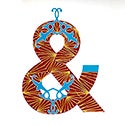 Negar Nahidian’s work incorporates classical Persian motifs and elements of style with modern design and technique, weaving together the aesthetics of multiple cultures.
Negar Nahidian’s work incorporates classical Persian motifs and elements of style with modern design and technique, weaving together the aesthetics of multiple cultures.
Persiatica reflects the designer’s love for typography and Persian motifs. Melding the popular typeface Helvetica with Persian motifs taken from rugs and tile works, she represents the reality of so many, where two cultures come together, giving shape to an even richer existence. The colors  Red, white, and blue form a common theme amongst both cultures.
Red, white, and blue form a common theme amongst both cultures.
Nahidian was born in Iran and came to the United States when she was five years old. Her family moved back after the Islamic Revolution in hopes of a better life. When many were fleeing the country, she lived her middle and high school years in Iran during the war with Iraq.
Jesuit Students and the Arts
From the earliest days of the Society of Jesus, Jesuit education embraced the arts as a part of the studia humanitatis, the classical education model of the Renaissance, with Jesuits penning plays, poetry, and music. At Woodstock College (1869-1974), the Jesuit seminary connected with Georgetown, seminarians continued this tradition, writing multilingual poetry collections in beautifully decorated hand-written notebooks, a few of which can be seen here.
Just like their forebears in the 16th century, Woodstock Jesuits also staged popular plays, such as “Johnny Pye and the Fool-Killer,” and “The Mikado.” They also tried their hand at playwriting themselves, producing an original musical in 1944 titled, “The Man in the Three-Cornered Hat,” an allegorical tale mixing history, Catholic theology, and American folk tales. A copy of the script, and photo of the cast, can be seen here from the Woodstock Theological Library’s Collection.
While the formation of choirs was a point of controversy in the earliest days of the society, Woodstock Jesuits were deeply engaged with music, forming glee clubs, orchestras, and even a folk group, The Woodstock Jesuit Singers. In a brief moment of fame, The Singers performed on “The Ed Sullivan Show,” and released a record, shown here.
REJECTION
We have all experienced it. Maybe in person, by letter, by phone call, or lately by tweet. What drives creative people to continue after a rejection – whether by a publisher, an audience, or a close personal friend? Audience members created a riotous atmosphere at the end of the premier of Igor Stravinsky’s Rite of Spring; artists Pablo Picasso, Paul Cézanne, Andy Warhol, and many others had original works panned by critics. Former poet laureate W.S. Merwin received this exceedingly polite rejection from his close friend and editor of the Kenyon Review, John Crowe Ransom. And current artists Madonna and U2 received stinging rejections. Some people believe that rejection breeds determination.
Robert Pirsig certainly did not give up. His Zen and the Art of Motorcycle Maintenance was rejected over 100 times before becoming a bestseller. The other books in the case were all rejected over two dozen times. How will you react to your next rejection?
COMPLETION
Invention is a creative process. In 1883, American army officer E.O.C. Ord II invented a pencil with a holder that could be used to measure distances. The Ord Family papers also include a diagram of a new gold pan to be used in gold mining although it is unclear if Ord invented it. Nonetheless, the diagram was meaningful to his family as his father, U.S. army officer E.O.C. Ord I, had visited the gold mines of California in 1848 in the early days of the California gold rush.
Corresponding is a creative process. Artists can use various media to express themselves. For example, the Turkish artist Huseyin Halit made drawings to accompany text in his letters to his friend John L. Brown, a U.S. diplomat. The drawings accentuate the letters.
 Drawing is a creative process. The joy of designing toys for children is apparent in the work of Helen King Boyer, an artist from Pittsburgh, Pennsylvania who worked for the Superior Toy and Novelty Corporation in Kansas City, Missouri. On display is a plan for making a sit-up bunny.
Drawing is a creative process. The joy of designing toys for children is apparent in the work of Helen King Boyer, an artist from Pittsburgh, Pennsylvania who worked for the Superior Toy and Novelty Corporation in Kansas City, Missouri. On display is a plan for making a sit-up bunny.
Protecting creative works is sometimes necessary. Documents can ensure ownership rights to forms of creation. The 1939 contract signed by Katherine Hepburn for the movie rights to “The Philadelphia Story” protected the intellectual property of that artistic work.
INSPIRATION | Texts
—One who sings, prays twice.
attr. Søren Kierkegaard
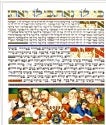 Scribes, illuminators, binders, and others used their creative talents to help create these beautiful texts.
Scribes, illuminators, binders, and others used their creative talents to help create these beautiful texts.
There is a critical need for ongoing reflection upon, respect for, and understanding of religious traditions, issues, questions, and values.
Light & Shadow
To progress again, man must remake himself. And he cannot remake himself without suffering. For he is both the marble and the sculptor. In order to uncover his true visage he must shatter his own substance with heavy blows of his hammer.
Alexis Carrel, Man, The Unknown (1935)
 In 1912 he won the Nobel Prize for his vascular suture, still in use today. From that point on began a chain of experimental advances by Dr. Carrel and his collaborators, from the development of antisepsis to tissue grafting and organ transplantation, to cellular senescence and the cultivation of organs in vitro. Each discovery seems to have propelled Dr. Carrel in new directions and his books, articles, and interviews reflect an unbounded confidence in his abilities, through science, to cure humanity of its manifold ills.
In 1912 he won the Nobel Prize for his vascular suture, still in use today. From that point on began a chain of experimental advances by Dr. Carrel and his collaborators, from the development of antisepsis to tissue grafting and organ transplantation, to cellular senescence and the cultivation of organs in vitro. Each discovery seems to have propelled Dr. Carrel in new directions and his books, articles, and interviews reflect an unbounded confidence in his abilities, through science, to cure humanity of its manifold ills.
 The documents and images left to us in the papers of Alexis Carrel are a record of the doctor’s immense confidence and creative energy, and of his drive to apply scientific research to every aspect of human life and society. It would be difficult to calculate the meaning of Dr. Carrel’s work in terms of lives saved; nevertheless, Carrel’s fascination with eugenics and the reshaping of civilization, with its attendant moral problems, casts a shadow across his many discoveries. Looking back, Dr. Carrel’s work might seem to have more in common with his fictional forebears, Drs. Frankenstein and Moreau, than with the other pioneers of surgery.
The documents and images left to us in the papers of Alexis Carrel are a record of the doctor’s immense confidence and creative energy, and of his drive to apply scientific research to every aspect of human life and society. It would be difficult to calculate the meaning of Dr. Carrel’s work in terms of lives saved; nevertheless, Carrel’s fascination with eugenics and the reshaping of civilization, with its attendant moral problems, casts a shadow across his many discoveries. Looking back, Dr. Carrel’s work might seem to have more in common with his fictional forebears, Drs. Frankenstein and Moreau, than with the other pioneers of surgery.
Associations
Art itself has become an extraordinary thing - the activity of peculiar people - people who become more and more peculiar as their activity becomes more and more extraordinary.
Eric Gill, Art and a Changing Civilisation, (1934)
People engaged in creative processes often arouse curiosity in those who witness the event; “looking over someone’s shoulder” is a universal temptation. There are many more reasons, in addition to this basic curiosity, that draw people together in the creation of things.
 Displayed in this case are images from the community of artists and friends surrounding the stone carver and letterer Eric Gill. On the top shelf, from left to right are: a letter from Gill to a young Mike Richey (1936), offering advice on carving, with illustrations; photograph of master and apprentice, Gill and Richey working on The Creation of Adam (1938) at the League of Nations; engraving by Gill based on a drawing by Gill and Richey’s mutual friend, the artist and poet David Jones, with a remembrance by Richey of the events surrounding its creation. At right is a stone carving featuring lettering by Gill and dove by Richey.
Displayed in this case are images from the community of artists and friends surrounding the stone carver and letterer Eric Gill. On the top shelf, from left to right are: a letter from Gill to a young Mike Richey (1936), offering advice on carving, with illustrations; photograph of master and apprentice, Gill and Richey working on The Creation of Adam (1938) at the League of Nations; engraving by Gill based on a drawing by Gill and Richey’s mutual friend, the artist and poet David Jones, with a remembrance by Richey of the events surrounding its creation. At right is a stone carving featuring lettering by Gill and dove by Richey.
At bottom are seen items pertaining to other “creative” associations. On the left are letters from the American philosopher Charles Augustus Strong to his friend George Santayana, engaged in the development of his panpsychist theory of consciousness in dialogue with other philosophers; to the right are diaries (1944-1953) by artist Prentiss Taylor recording his experiences with poet Ezra Pound while working as an art therapist at St. Elizabeth’s hospital.
Cutting & Pasting
There are books in which the footnotes, or the comments scrawled by some reader's hand in the margin, are more interesting than the text. The world is one of those books.
George Santayana
 From a certain perspective, the creative process is that which separates the conception of a thing and its final expression, the part where problems are solved and work is done. Today, nearly all of us cut & paste, copy, and self-publish to some extent, the beneficiaries of digital tools. Before these were available, however, there was the actual cutting & pasting, copying, and other tasks necessary to production- more often than not the responsibility of the creator. How might our writing have changed, now that we automate tasks like these?
From a certain perspective, the creative process is that which separates the conception of a thing and its final expression, the part where problems are solved and work is done. Today, nearly all of us cut & paste, copy, and self-publish to some extent, the beneficiaries of digital tools. Before these were available, however, there was the actual cutting & pasting, copying, and other tasks necessary to production- more often than not the responsibility of the creator. How might our writing have changed, now that we automate tasks like these?
Here we see examples of manuscripts in various states by the popular English author Montague Summers for the weekly magazine Everybody’s, displaying finished drafts and galleys, with illustrations researched and reproduced by Summers. From the 1930’s through World War II, Summers wrote brief articles for Everybody’s on subjects ranging from Gothic literature to folklore to local histories.
Below these: a manuscript page from Summers’ history of the Gothic novel, with attachments, circa 1935; examples from the papers of philosopher George Santayana demonstrating a highly “destructive” method of creating new works.
Working Drafts
Writing is more like a sculpture where you remove, you eliminate
in order to make the work visible. Even those pages you remove
somehow remain.[1]
~ Elie Wiesel
Holocaust survivor, author, Nobel Laureate
Archival musical manuscripts give us a glimpse into composers and their creative processes, and the opportunity to see early stages of their works. Scribbles and crossed-out sections can seem disorganized and frantic, yet, underneath, we can see what may have been. Sometimes we see errors, which in some cases are crossed out with no explanation. Working with these materials is an intimate experience, seeing false starts, errors, and corrections which the composer never intended for the outside world to see. What we see are “thoughts left visible.”[2]
These objects show the messy, the frustrated, and the unrefined thoughts of major composers in the western art music canon from the 19th and 20th centuries, including Adolphe Adam, Margaret Bonds, Jerome Kern, Jules Massenet, Ignaz Moscheles, Ottorino Respighi, and Ralph Vaughan Williams. Some of these pieces were never published at all, some were published yet the draft is almost indistinguishable from the final work, and some have become recognizable classics.
Musicians and listeners often only interact with the finished work, transcribed by copyists, edited and printed by publishers, and recorded for posterity. These documents and subsequent recordings are often far removed from their original works. Yet one must wonder if music is an aural art, what is a musical manuscript if not a mere set of directions for the performer ? Is sheet music actually music, if it is not performed and listened to?
In order to fully appreciate these pieces on display, visit Spotify to hear a sampling of the finished works: https://spoti.fi/2TBK4Vv
[1] John S. Friedman, “The Art of Fiction” in Elie Wiesel: Conversations, ed. Robert Franciosi, (Jackson: University Press of Mississippi, 2002) 72.
[2] Kelly Baum, Andrea Bayer, and Sheena Wagstaff, Unfinished: Thoughts Left Visible, (New York: Metropolitan Museum of Art Press, 2016)
Moderators (not curators): Lynn Conway, Mat Darby, Ann Galloway, Ethan Henderson, Stephanie Hughes, Ted Jackson, Jayme Kurland, Lisette Matano, Negar Nahidian, Meg Oakley, Amy Phillips, Christen Runge, Scott Taylor, Adrian Vaagenes, LuLen Walker

















